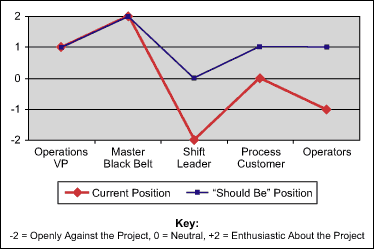
How does a company measure the effectiveness of a Six Sigma program? Common metrics include: time to the break-even point for the program, project completion rate, total and average financial value of completed Six Sigma projects, and average project completion time. The common element in all these metrics is that they rely on the effectiveness of the process improvement projects (or design projects) led by project managers – usually Black Belts (or Green Belts in the case of smaller projects).
Thus effective project leadership is a key to program success. And the key for Black Belts to be effective project leaders is to have not only the technical expertise to manage a project to completion, but non-technical expertise as well.
Technical expertise usually includes DMAIC (Define, Measure, Analyze, Improve, Control) or DFSS (Design for Six Sigma) tools, methods and approaches – being able to select the right tool at the right time, and being able to execute the selected tool appropriately. What is just as important is non-technical expertise, often called “soft skills.” That expertise involves the Black Belt’s ability to mobilize, or motivate, the right people at the right time in the right way. It requires mobilizing three different sets of people – oneself, the team and stakeholders.
First, Mobilize Oneself
Contrary to popular belief, the ability to mobilize is not a fuzzy thing that “some Black Belts just have, some do not.” Everyone can learn and improve mobilizing skills and hence be more effective in Six Sigma project work. The place to start is with oneself.
Before Black Belts can effectively mobilize their team or stakeholders, they need to understand how they, themselves, respond to change and what triggers their own resistance. They need to know how they deal with conflict and how good they are as communicators and listeners. To paraphrase a Chinese proverb, “You cannot understand other people before you have a clear understanding of yourself.” Some instruments and techniques useful for understanding one’s own strengths and weaknesses in the role of mobilizer include:
A Personal SWOT Analysis – A guided personal SWOT (strengths/weaknesses/opportunities/threats) analysis is an effective self-awareness technique. It can be conducted and supported either by internal or external coaches or during a training course. With such an analysis, Black Belts also come to appreciate the corresponding opportunities and threats regarding their mobilizing capabilities.
Because it avoids focusing only on one’s weaknesses and trying to eliminate them, a personal SWOT analysis provides concrete input for two important questions:
- In the short-term, how does a team leader approach the people who need to be influenced or mobilized in the current project?
- From a mid- to long-term perspective, what are fruitful fields of personal development and what are appropriate actions to achieve personal development goals?
In the short-term, a project leader’s mobilizing strategy should build on his or her existing strengths and work around weaknesses. For example, if the leader is a weak facilitator, that role should be handed over to a better qualified team member so this weakness will not hinder the project work. Improving facilitating skills is a mid- or long-term goal that needs practice before it is applied during a Six Sigma program.
Soliciting Feedback – Constructive feedback – for example, 360-degree feedback provided by senior management, colleagues, direct reports and customers – is an effective tool. It provides a comprehensive look at how one is perceived. Often, feedback reveals deficiencies in mobilizing of which Black Belts might not be aware.
While feedback systems are widespread in the business world, too often they are poorly implemented. Feedback steps are simple and relatively easy to follow. However, if the culture is not supportive in terms of promoting transparency, trust and honesty, both providing and receiving feedback can be tough. Maybe because personal feelings are part of constructive feedback, it is often seen in a negative light. A project leader serves as a role model in many ways: Giving and receiving feedback is an important competency of leadership.
A coaching relationship with an internal or external coach can help improve feedback skills, as can a “buddy system” – using a peer for ongoing bi-directional support. Project leaders can accelerate their progress toward this development goal by voicing commitments and asking a peer to be responsible for checking frequently to see if they are on track.
Understanding Motivation – Before project leaders start work on a project and begin mobilizing people, they need to be committed to the project. Were all the necessary and sometimes difficult questions asked of the sponsor? Is the project leader really convinced of the goal of the project? Is the project leader really mobilized to work hard to make the project a success and hence motivate people?
If a Black Belt cannot answer “yes” to these questions, most of the techniques and skills to mobilize people will fail. In working on the project, the central question project leaders should ask of themselves and of the organization is “What’s in it for me?” The answers not only will ensure an effective team can be formed, but also will serve as a mobilizer throughout the project.
Mobilize the Team
Just as “What’s in it for me?” helps project leaders to find their momentum and motivation, it is a critical question for the stakeholders in general and team members specifically. In fact, it is a major component of successful team effectiveness models.
The ideal beginning for a project team is this scenario: The Black Belt returns from a first week of training fully energized and mobilized and finds hundreds of willing colleagues eager to work on the project team. However, the reality is more likely to be: The Black Belt returns to find people are already working hard, spending lots of time in meetings; and the best people are already engaged in other teams.
Nonetheless, the right team members – those necessary for process expertise and sustainable results – must be selected. Sponsors and process owners are responsible for helping form the team, but project leaders are responsible for asking for their help and support. Once project leaders figure out who is needed on the team, team mobilization starts and continues through all the ups and downs of the project. Good project leaders do this by constantly putting themselves in the shoes of each team member.
The Black Belt’s first mobilizing step is to get everyone on the team to buy into the project and be effective team members. To do this, the project leader needs to revisit the question, “What’s in it for me?” from the team member’s perspective. Sometimes there may not seem to be too much in it for the team members, since they are commonly required to participate. The project leader, though, can make a difference by asking team members what each would like to get from being on the team. Those discussions can come in one-on-one talks or as part of a gathering at the beginning of the project.
In addition, the project leader’s preparation for meetings can help team members know what they will get out of particular aspects of the project, as well as a particular meeting.
Knowledge of the team dynamics model helps project leaders both in planning and conducting meetings. For example, if the team is in a phase where everybody is searching for his role and competition is present (storming phase), there is no way to make an important decision like agreeing on a data collection plan, because support is needed by each team member.
Clarity about goals, roles and procedures for things like decision making will make the team’s work both more effective and more efficient. And if interpersonal problems occur, this team effectiveness model serves as an instrument for diagnosis as well.
Institutionalized mutual feedback can help make a mediocre team into an excellent one. Rather than hinder teams as they go through difficult times, mutual feedback helps them manage the challenges in a more efficient and effective way and learn from them too, benefiting the project and the personal development of each team member as well.
Mobilize the Stakeholders
What are the benefits of a project to any of the affected people – the stakeholders, who may include upper management, colleagues and customers? What are the costs or inconveniences? Again, it comes back to the question, “What’s in it for me?” To get a legitimate answer for stakeholders, Black Belts need to listen actively and take an honest interest in every group of stakeholders and their needs.

Black Belts should list all the possible stakeholders and their initial opinion towards the project, recognizing that both the list and the opinions may change. If all goes well, the changes will be in the direction Black Belts want them to change. And this depends on thorough and regularly reviewed stakeholder analysis planning (see figure to the right).
Key questions for a stakeholder analysis include:
- What specifically is needed from the stakeholder?
- How might this stakeholder benefit from the project and what might this project cost the stakeholder?
- What is the stakeholder’s probable response to the request?
- What is the gap between what the stakeholder is offering and what the Black Belt wants to get?
Part of the stakeholder planning and mobilizing strategy is a communication plan and strategy that informs each stakeholder – at the right time and in the right way – about relevant information, like project status.
Conclusion: One Can Learn to Mobilize
There are ways of improving mobilizing skills if a project leader is genuinely interested in the people he or she leads or wants to mobilize. It starts with a personal decision to be more self-aware. Developing or changing one’s behavior takes time, lots of practice, feedback, more practice and self-reflection. But it is absolutely worth the journey – both for the success of projects and of the personal and professional growth of the Black Belt.